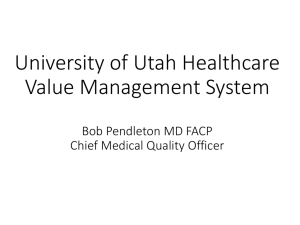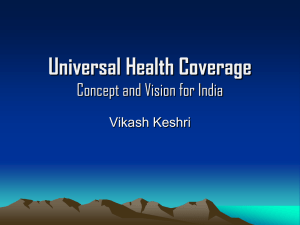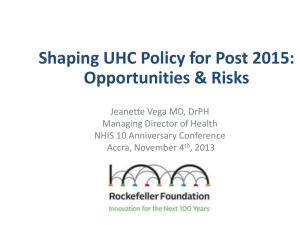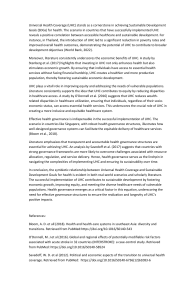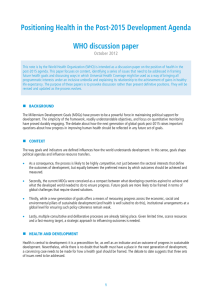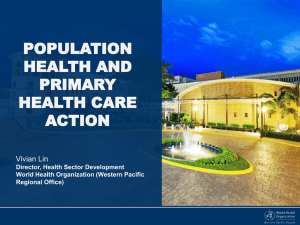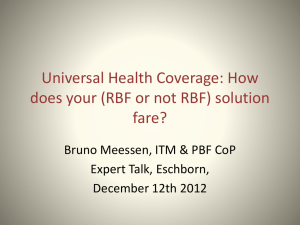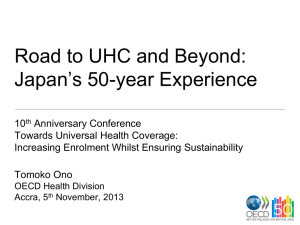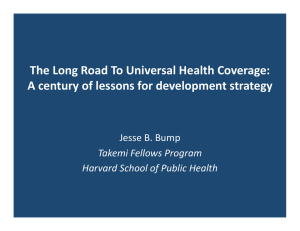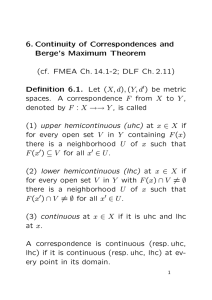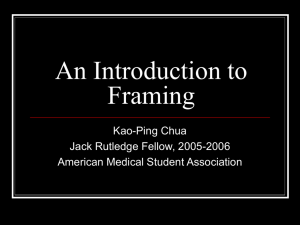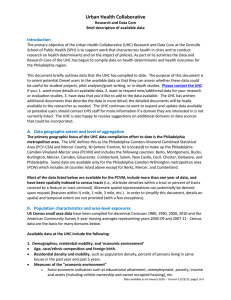Universal health coverage: Old wine in a new bottle? If so, is that so
advertisement
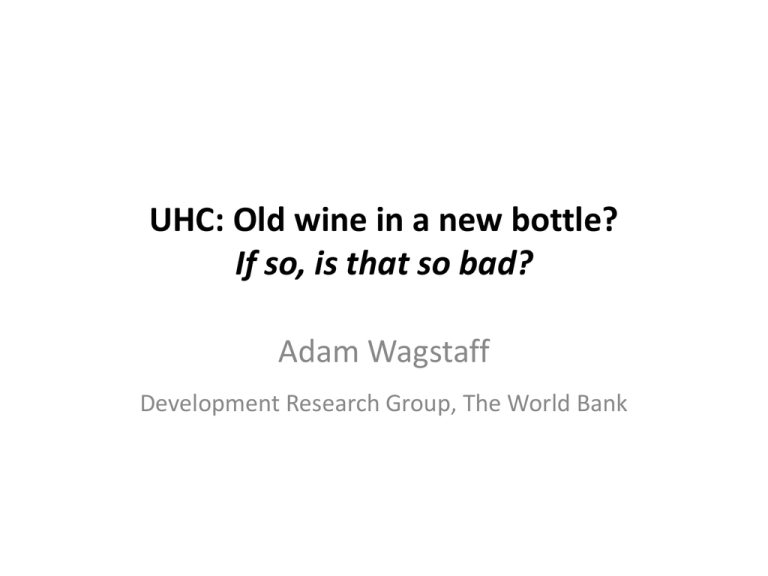
UHC: Old wine in a new bottle? If so, is that so bad? Adam Wagstaff Development Research Group, The World Bank At the start, the idea of UHC must have seemed straightforward enough • Lots of countries "covered" only part of their population, and several were making efforts to expand coverage to "uncovered" populations • UHC was all about extending coverage to “uncovered” groups • Thailand led the way in the terminology, and somewhat confusingly even had a “UC scheme” (that covered only part of the population)! But wait a minute! Didn’t we already have UHC? • Govt. facilities are subsidized everywhere—nobody pays the full cost • In which case isn’t coverage already universal? • So what really is the problem? – It’s not that some people lack coverage – Rather it’s that some people have deeper coverage than others – People outside a "scheme" (the poor?) are liable for higher out-of-pocket payments than those inside a "scheme" • So we need a 2nd coverage dimension—depth • Q1: How deep? "Full" coverage? It’s not just financial coverage • What about the health benefits associated with expanding and deepening coverage? • Could “UHC” initiatives be skewed – against low-cost but highly effective interventions – in favor of costly inpatient and pharmaceutical-based interventions with limited effectiveness? • Don’t we need to think about what is covered, not just who is covered and how deeply? • Q2: What do we cover? Everything—i.e. "comprehensive" coverage? A cube is born • It helps, but… • Only one dimension is reflected in the name UHC—the “U” • And it’s the one that’s least helpful, because everyone already has (some) coverage! • Soon people also started asking awkward questions about what’s meant by the edges of the cube How deep? UHC What? Who? (Everyone) De jure vs. de facto—services • What if a country promises services but doesn't actually deliver them? • People may not get the services they're entitled to given their needs • Health workers are absent, drugs aren’t available, etc. • Studies using standardized/fake patients show that providers often fail to make the correct diagnosis. And when they, do they often fail to prescribe the right treatment • Use of vignettes to assess competence reveal it’s not always due to ignorance. Providers often they fail to do everything they know they should do—there’s a “know-do” gap De jure vs. de facto—payments • Financial coverage is about what people pay in practice • And it’s about how "affordable" these payments are • Patients may end up paying more out-of-pocket than they expect to on the basis of what's written on paper • Providers may deliberately overprescribe to make money • Or they may deliberately switch to a more resourceintensive style of care • Paradoxically expanding coverage may lead to larger out-of-pocket payments, and hence shallower coverage Old wine in a new bottle • Ultimately what we’re interested in is that in practice – Everyone—rich and poor—should get the health services they need – Nobody should suffer undue financial hardship as a result of getting the health care they need • Note that first aspect (service coverage) captures quality: – If people are misdiagnosed, or get the wrong treatment despite the right diagnosis, they’re not getting the care they need • UHC isn’t really new after all The ethical imperative of UHC • Everyone—rich and poor—should get the health services they need – Being healthy is a precondition to flourishing as a human being – It’s hard to argue for anything other than an equal distribution of health – People don’t choose to get ill—they get unlucky – Leads to the injunction “treat according to need and not according to ability-to-pay” • Nobody should suffer undue financial hardship as a result of getting the health care they need – Having sufficient resources is also a precondition to flourishing as a human being – Together with the points above leads to the injunction “ensure payments for needed health care don’t cause undue financial hardship” A practical and easily understood approach Everyone—rich and poor—should get the health services they need Nobody should suffer undue financial hardship as a result of getting the health care they need • Agree on a set of “tracer” service needs that ought to be covered spanning (a) all types of health service (including curative care), and (b) all stages of the lifecycle. • Vary list by level of development • Use surveys w/ gadgets for preventive care and management of NCDs, and fake patients to see whether people get the services they need • We’d like to see faster progress among the poorest 40% • Interpret “undue financial hardship” as a household being forced into poverty • Look at actual out-of-pocket payments sampled households make, and see whether they’re sufficient to push the household below the e.g. $1.25-a-day poverty line • We’d like to see the number of “medically impoverished” households fall over time and ultimately reach zero Immunization Green means faster progress among the poorest 40%
